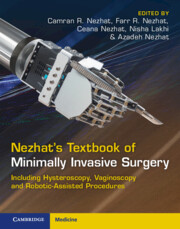 Nezhat's Textbook of Minimally Invasive Surgery
Nezhat's Textbook of Minimally Invasive Surgery Book contents
- Nezhat’s Textbook of Minimally Invasive Surgery
- Nezhat’s Textbook of Minimally Invasive Surgery
- Copyright page
- Dedication
- Contents
- Online Resources
- Contributors
- Foreword
- Preface
- Chapter 1 A History of Modern-Day Video Surgery with and without Robotic Assistance
- Chapter 2 Equipment for Operative Laparoscopy and Hysteroscopy
- Chapter 3 Anesthesia
- Chapter 4 Patient Positioning and Operating Room Setup
- Chapter 5 Laparoscopic Access
- Chapter 6 Laparoscopic Suturing
- Chapter 7 Pelvic Anatomy
- Chapter 8 Hysteroscopy
- Chapter 9 Fertility
- Chapter 10 Management of Adnexal Masses
- Chapter 11 Endometriosis
- Chapter 12 Video Laparoscopic Adhesiolysis and Adhesion Prevention
- Chapter 13 Video Laparoscopic Sterilization
- Chapter 14 Leiomyomas
- Chapter 15 Hysterectomy
- Chapter 16 Pelvic Floor Procedures
- Chapter 17 Video Laparoscopy
- Chapter 18 Gynecologic Malignancy
- Chapter 19 Video Laparoscopic Surgery during Pregnancy
- Chapter 20 Pediatric Surgery
- Chapter 21 Video Laparoscopic Aortic Surgery
- Chapter 22 Additional Procedures for Pelvic Surgeons
- Chapter 23 Simulation Training in Minimally Invasive Surgery
- Chapter 24 Robotic-Assisted Laparoscopy
- Chapter 25 Vascular Surgery and Management of Pelvic Complications
- Chapter 26 Fetal Surgery
- Chapter 27 Hemostatic Agents in Minimally Invasive Surgery
- Chapter 28 New Techniques in Minimally Invasive Surgery
- Book part
- Index
- References
Chapter 18 - Gynecologic Malignancy
Published online by Cambridge University Press: 06 November 2025
- Nezhat’s Textbook of Minimally Invasive Surgery
- Nezhat’s Textbook of Minimally Invasive Surgery
- Copyright page
- Dedication
- Contents
- Online Resources
- Contributors
- Foreword
- Preface
- Chapter 1 A History of Modern-Day Video Surgery with and without Robotic Assistance
- Chapter 2 Equipment for Operative Laparoscopy and Hysteroscopy
- Chapter 3 Anesthesia
- Chapter 4 Patient Positioning and Operating Room Setup
- Chapter 5 Laparoscopic Access
- Chapter 6 Laparoscopic Suturing
- Chapter 7 Pelvic Anatomy
- Chapter 8 Hysteroscopy
- Chapter 9 Fertility
- Chapter 10 Management of Adnexal Masses
- Chapter 11 Endometriosis
- Chapter 12 Video Laparoscopic Adhesiolysis and Adhesion Prevention
- Chapter 13 Video Laparoscopic Sterilization
- Chapter 14 Leiomyomas
- Chapter 15 Hysterectomy
- Chapter 16 Pelvic Floor Procedures
- Chapter 17 Video Laparoscopy
- Chapter 18 Gynecologic Malignancy
- Chapter 19 Video Laparoscopic Surgery during Pregnancy
- Chapter 20 Pediatric Surgery
- Chapter 21 Video Laparoscopic Aortic Surgery
- Chapter 22 Additional Procedures for Pelvic Surgeons
- Chapter 23 Simulation Training in Minimally Invasive Surgery
- Chapter 24 Robotic-Assisted Laparoscopy
- Chapter 25 Vascular Surgery and Management of Pelvic Complications
- Chapter 26 Fetal Surgery
- Chapter 27 Hemostatic Agents in Minimally Invasive Surgery
- Chapter 28 New Techniques in Minimally Invasive Surgery
- Book part
- Index
- References
Summary
Since the introduction of laparoscopic surgery in the early 1900s, traditional surgeons have met it with skepticism. However, after decades of modern advances in technology, including improved lens systems, cold light, fiber optics, and especially the development of video endoscopy by Dr. Camran Nezhat, combined with the pioneering work of the early gynecologic surgeons, minimally invasive video laparoscopy and robotics have made inroads into the diagnosis and treatment of gynecologic oncology.[1,2] The first video laparoscopic radical hysterectomy, para-aortic and pelvic lymphadenectomy, was performed by the Nezhats in 1989 and reported in subsequent years.
Information
- Type
- Chapter
- Information
- Nezhat's Textbook of Minimally Invasive SurgeryIncluding Hysteroscopy, Vaginoscopy and Robotic-Assisted Procedures, pp. 529 - 688Publisher: Cambridge University PressPrint publication year: 2025
References
References
References
References
References
References
References
References
References
References
References
References
References
References
References
Accessibility standard: WCAG 2.0 A
Why this information is here
This section outlines the accessibility features of this content - including support for screen readers, full keyboard navigation and high-contrast display options. This may not be relevant for you.Accessibility Information
Content Navigation
Allows you to navigate directly to chapters, sections, or non‐text items through a linked table of contents, reducing the need for extensive scrolling.
Provides an interactive index, letting you go straight to where a term or subject appears in the text without manual searching.
Reading Order & Textual Equivalents
You will encounter all content (including footnotes, captions, etc.) in a clear, sequential flow, making it easier to follow with assistive tools like screen readers.
You get concise descriptions (for images, charts, or media clips), ensuring you do not miss crucial information when visual or audio elements are not accessible.
Visual Accessibility
You will still understand key ideas or prompts without relying solely on colour, which is especially helpful if you have colour vision deficiencies.
Structural and Technical Features
You gain clarity from ARIA (Accessible Rich Internet Applications) roles and attributes, as they help assistive technologies interpret how each part of the content functions.